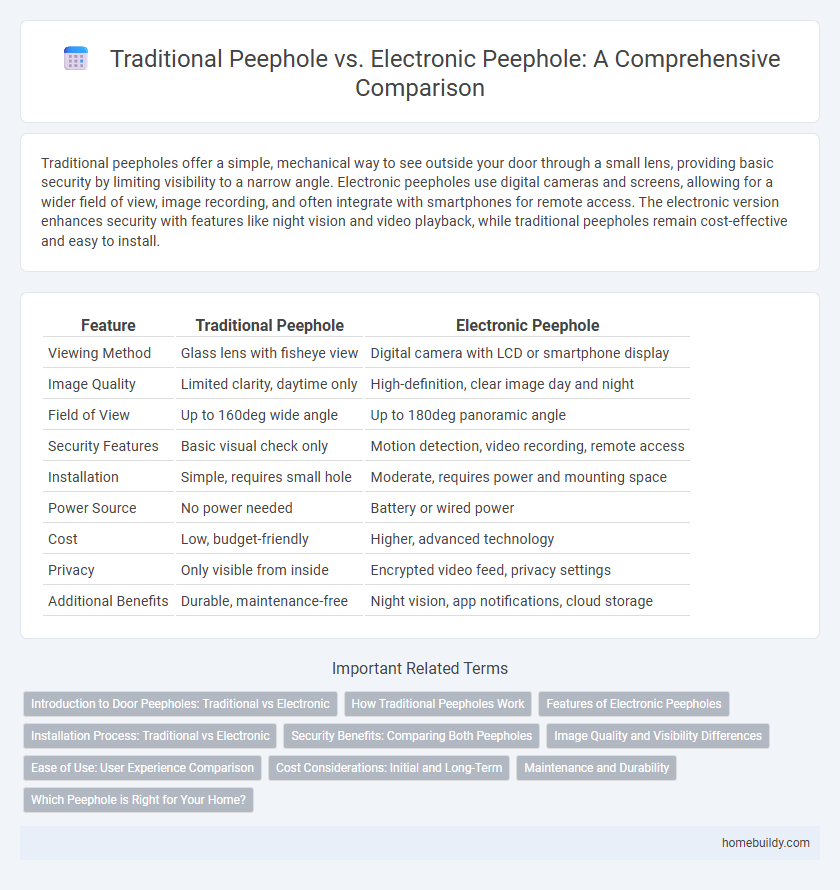Traditional peepholes offer a simple, mechanical way to see outside your door through a small lens, providing basic security by limiting visibility to a narrow angle. Electronic peepholes use digital cameras and screens, allowing for a wider field of view, image recording, and often integrate with smartphones for remote access. The electronic version enhances security with features like night vision and video playback, while traditional peepholes remain cost-effective and easy to install.
Table of Comparison
| Feature | Traditional Peephole | Electronic Peephole |
|---|---|---|
| Viewing Method | Glass lens with fisheye view | Digital camera with LCD or smartphone display |
| Image Quality | Limited clarity, daytime only | High-definition, clear image day and night |
| Field of View | Up to 160deg wide angle | Up to 180deg panoramic angle |
| Security Features | Basic visual check only | Motion detection, video recording, remote access |
| Installation | Simple, requires small hole | Moderate, requires power and mounting space |
| Power Source | No power needed | Battery or wired power |
| Cost | Low, budget-friendly | Higher, advanced technology |
| Privacy | Only visible from inside | Encrypted video feed, privacy settings |
| Additional Benefits | Durable, maintenance-free | Night vision, app notifications, cloud storage |
Introduction to Door Peepholes: Traditional vs Electronic
Traditional door peepholes provide a simple optical view using a fisheye lens embedded in the door, allowing occupants to see who is outside without opening the door. Electronic peepholes incorporate a digital camera and LCD screen or smartphone connectivity, offering enhanced visibility, night vision, and recording capabilities. The choice between traditional and electronic peepholes depends on security needs, budget, and technological preference.
How Traditional Peepholes Work
Traditional peepholes work by using a convex lens installed in the door, allowing residents to see a wide-angle view of the outside without opening the door. These optical devices rely entirely on ambient light and direct line of sight to provide a clear, magnified image of visitors. Unlike electronic peepholes, traditional models require no power source and have no digital features, offering a simple, reliable means of security.
Features of Electronic Peepholes
Electronic peepholes offer high-definition video display, motion detection, and night vision capabilities, enhancing security and convenience beyond traditional peepholes. These devices often include wide-angle lenses, digital zoom, and smartphone connectivity, allowing remote monitoring and real-time alerts. Unlike traditional peepholes, electronic models provide enhanced image clarity and privacy without the need to physically approach the door.
Installation Process: Traditional vs Electronic
Traditional door peepholes are installed by drilling a small hole through the door, typically requiring minimal tools and no electrical wiring. Electronic peepholes involve a more complex installation process, as they need a power source, internal camera mounting, and sometimes Wi-Fi connectivity setup. The electronic option often requires professional assistance due to its integration with smart home systems and higher technical demands.
Security Benefits: Comparing Both Peepholes
Traditional peepholes offer a basic security benefit by allowing occupants to view visitors without opening the door, but their limited viewing angle and small lens size can reduce visibility and increase blind spots. Electronic peepholes enhance security by providing a wider, clearer field of view through digital cameras, night vision, and real-time video playback, often combined with smartphone connectivity for remote monitoring. These advanced features enable more accurate identification of visitors and improved deterrence of potential intruders compared to conventional peepholes.
Image Quality and Visibility Differences
Traditional peepholes provide a limited fisheye view with low image clarity and narrow visibility range, often distorted due to lens curvature and lighting conditions. Electronic peepholes utilize digital cameras and LCD screens, offering high-resolution images with adjustable brightness and wider field of view, enhancing security by enabling clear identification at various distances. The electronic models also allow recordings and night vision features, significantly improving image quality and visibility compared to conventional optical peepholes.
Ease of Use: User Experience Comparison
Traditional peepholes offer a straightforward, mechanical design requiring no power, allowing quick visual checks through a small lens but often provide limited field of view and clarity. Electronic peepholes enhance ease of use with digital screens or smartphone integration, delivering wider angles, zoom capabilities, and clear images even in low light, improving overall user experience. Touchscreen interfaces and motion detection features simplify operation and increase security, making electronic peepholes more user-friendly despite reliance on battery power.
Cost Considerations: Initial and Long-Term
Traditional peepholes typically have a low initial cost, often under $20, making them an affordable option for basic security needs. Electronic peepholes involve a higher upfront investment, ranging from $50 to $200, due to advanced features like digital displays and cameras, but they offer long-term benefits such as enhanced security and convenience. Maintenance costs for electronic peepholes may include battery replacements or software updates, whereas traditional peepholes require minimal to no ongoing expenses.
Maintenance and Durability
Traditional peepholes require minimal maintenance but are prone to scratches and limited durability due to exposed glass lenses. Electronic peepholes offer enhanced durability with sealed digital components and require periodic charging or battery replacement to ensure functionality. Long-term usability favors electronic peepholes for their resistance to wear and tear compared to mechanical degradation in traditional models.
Which Peephole is Right for Your Home?
Traditional peepholes offer a simple, cost-effective way to view visitors through a small lens embedded in the door, providing a wide-angle perspective without the need for power or maintenance. Electronic peepholes enhance security with features like high-definition video display, night vision, and remote viewing via smartphone, making them ideal for tech-savvy homeowners seeking advanced monitoring. Choosing the right peephole depends on your budget, security needs, and preference for convenience or technological integration in your home.
Traditional peephole vs Electronic peephole Infographic

 homebuildy.com
homebuildy.com